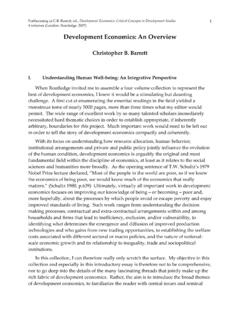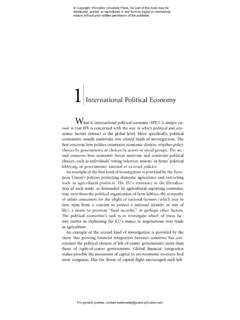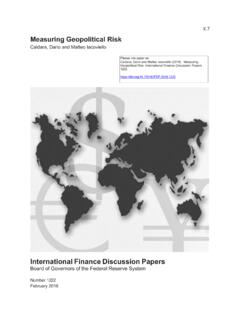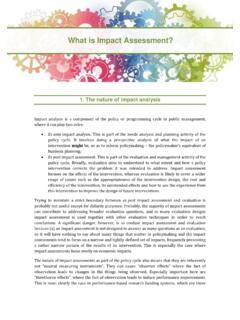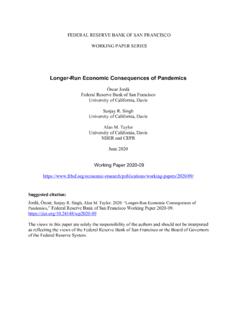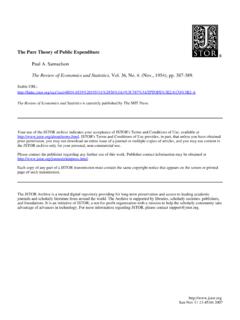Transcription of Chapter 7 The Ramsey model - ku
1 Chapter 7 The Ramsey modelAs early as 1928 a sophisticated model of a society s optimal saving was pub-lished by the British mathematician Frank Ramsey (1903-1930). Ramsey scontribution was mathematically demanding and did not experience a strongresponse at the time. Three decades had to pass until his contribution wastaken up seriously (Samuelson and Solow, 1956). The model was fusionedwith Solow s simpler growth model (Solow 1956) and became a cornerstonein neoclassical growth theory from the mid 1960s. The version of the modelwhich we present below was completed by the work of Cass (1965) and Koop-mans (1965). Hence the model is also known as model is one of the basic workhorse models of macroeconomics.
2 Itcanbeseenasplacedatoneendofalinesegmen t,withanotherworkhorsemodel as placed at the other end, namely Diamond s overlapping generationsmodel. In the Diamond model there is aninfinitenumber of agents (sincein every new period a new generation enters the economy) and these have afinitetime horizon. In the Ramsey model there is afinitenumber of agentswith aninfinitetime horizon; further, these agents are completely alike. TheRamsey model is thus arepresentative agentmodel, whereas the Diamondmodel has heterogeneous agents (young and old) interacting in every period,These differences in the basic setup turn out to have important implicationsfor the the line segment, which has these two frameworks as polar cases,less abstract models are scattered, some being closer to the one pole andothers closer to the other.
3 A given model may open up for different regimes,one close to Ramsey s pole, another close to Diamond s. An example isBarro s model , from Chapter 5, with parental altruism. When the bequestmotive is operative, the Barro model coincides with a Ramsey model (in dis-crete time). But when the bequest motive is not operative, the Barro model277278 Chapter 7. THE Ramsey model coincides with a Diamond OLG model . In later chapters we extend the per-spective by including government, public debt, money, market imperfectionsetc. It turns out that for several issues it matters a lot whether one uses aRamsey setup or an overlapping generations Ramsey framework can be formulated in discrete time as well as incontinuous time.
4 This Chapter concentrates on the continuous time versionas did Ramsey s original contribution. Wefirst study the Ramsey frameworkunder the conditions of a perfect-competition market economy. In this con-text we will see that the Solow growth model comes out as a special caseof the Ramsey model . Next we consider the Ramsey framework in a settingwith an all-knowing and all-powerful social planner. The next Chapter ap-plies Ramsey s framework to a series of issues, including welfare implicationsof alternative policies to promote economic Market conditionsWe consider a closed economy. Time is continuous. At any point in timethere are three active markets, one for the all-purpose output good, onefor labor, and one for capital services (the rental market for capital goods).
5 For the sake of intuition, it can be useful to imagine that there is also a loanmarket, which we name the bond market, with a short-term interest rater. But since households are alike, in general equilibrium this market willnot be used. There is perfect competition in all markets, that is, prices areexogenous to the individual ideas, we assume that the households own the capital goods andhire them out the technology exhibits constant returns toscale and there is perfect competition, thefirms, owned by the householdsector as a whole, do not make (pure) profit in equilibrium. Any need formeans of payment money is abstracted away.
6 Prices are measured incurrent output the variables in the model are considered as continuous func-tions of time,t, we shall, to save notation, write them aswt,rt,etc. (insteadofw(t),r(t), etc.). In every short time interval(t,t+ t),the individualfirmemploys labor at the market wagewtand rents capital goods at the rentalrate rt. The combination of labor and capital produces the homogeneousoutput good. This can be used for consumption as well as instead thefirms owned the real capital while household s heldfinancial claims onthefirms (shares and bonds), the conclusions would remain unaltered as long as we Groth, Agents279 Since we assume that households understand precisely how the economyworks, they can predict the future path of wages and interest rates.
7 Thatis, we assume perfect foresight. Owing to this absence of uncertainty, theconsequences of a choice are rates of return on alternativeassets must in equilibrium be the same. So the (short-term) interest rate inthe bond market must equal the rate of return on real capital in equilibrium,that is,rt= rt ,( )where ( 0)is a constant rate of capital depreciation. This no-arbitragecondition shows how the interest rate is related to the rental rate of we present,first, the households behavior and, next, thefirms behavior. After this, the interaction between households andfirms in generalequilibrium will be AgentsThe householdsThere is afixed number of identical households with an infinite time feature makes aggregation very simple: we just have to multiply thebehavior of the single household with the number of households.
8 We mayinterpret the infinite horizon of the household as reflecting a Barro-stylealtruistic bequest motive (cf. Chapter 5). The household may thus be seen asa family dynasty whose current members act in unity and are also concernedwith the welfare of future generations. Every family hasLtmembers andLtchanges over time at a constant rate,n:Lt=L0ent.( )In contrast, in a standard OLG model births reflect the emergence ofneweconomic agents, that is, new decision makers whose preferences no-one hascared about in family member inelastically supplies one unit of labor per timeunit. Equation ( ) therefore describes the growth of the population aswell as the labor force.
9 Since there is only one consumption good, the onlydecision problem is how to distribute current income between consumptionand saving. The savings are placed in either real capital or short-term the household wishes to dissave, it can simply sell its stock of real capitalor issue household s preferences can be represented by an additive utilityfunction with a constant utility discount rate, ,called the rate of timeChristian Groth, 2010280 Chapter 7. THE Ramsey model preference or the rate of impatience. Seen from time0,the utility functionisU0=Z 0u(ct)Lte tdt,wherect Ct/Ltis consumption per family member. The instantaneousutility functionuhasu0>0andu00<0, , positive but diminishing mar-ginal utility.
10 The utility contribution from consumption per family memberis weighted by the number of family members, this way, it is the sumof the family members utility that counts which is whyU0is sometimes re-ferred to as aclassical-utilitarianutility function with discounting. Becauseof ( ),U0can be written asU0=Z 0u(ct)e ( n)tdt,( )where the unimportant positive factorL0has been eliminated. We may call ntheeffectiverate of time preference while is thepurerate of timepreference. We later introduce a restriction on nto ensure boundednessof the utility household chooses a consumption-saving plan which maximizesU0subject to a budget constraint.


